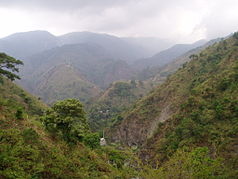Mount Pulag National Park
| Mount Pulag National Park | ||
|---|---|---|
| View of the Cordiliera Central Source: Kok Leng, Maurice Yeo | ||
|
|
||
| Location: | Philippines | |
| Specialty: | Volcanic area | |
| Surface: | 11,550 ha | |
| Founding: | 1987 | |
| The Cordillera Central | ||
The Mount Pulag National Park is a Philippine National Park in the north of Luzon . The mountain Pulag gives it its name .
The park was established by President Proclamation of the Philippines No. 75 on February 20, 1987 on an area of 11,550 hectares and serves to protect and preserve the natural features of the region, its diverse vegetation and wildlife. The park belongs to the Cordillera Biosphere Zone and is part of the National Protected Areas Program (NIPAS).
geography
Mount Pulag National Park is located in the center of the Cordillera Central , the main mountain range of the Philippine Cordilleras . It is located in the border area between the provinces of Cordillera Administrative Region (CAR) and Cagayan Valley (R2). The mountains in the park are characterized by steep slopes, ridges and cliffs on the mountain slopes with flowing transitions to the peaks of the mountain range.
The eponymous mountain , the Pulag, is located in the Mt. Pulag National Park . With a height of 2,922 meters above sea level, it is the highest mountain on Luzon and the second highest in the Philippines .
Flora Fauna
The high altitudes of the Pulag are treeless and overgrown with grass and dwarf bamboo ( Yushania niitakayamensis ). In lower elevations, the vegetation changes to a subtropical mountain rainforest full of ferns, lichens and mosses. The main tree species in this in the park is the Benguet pine ( Pinus insularis ), which grow on the barren, rocky slopes. The soils are said to be poor in nutrients. There are several species of orchids worth mentioning, some of which may be endemic to the national park, and other rare plants such as the pitcher plants .
Wildlife includes endangered mammals such as the Philippines deer and the giant bark rat Phloeomys pallidus and 33 endemic bird species.
Waterfalls, rivers and small lakes characterize the national park.
Culture
Several indigenous tribes of the Igarot settle in the area of the national park : the Ibaloi, the Kalanguya, the Kankana-ey and the Karaos. These have a rich cultural life with many rites and traditions. They call the area around the Pulag holy ground. Many of the stories from these tribes are about the spirits of trees, lakes and mountains.
The " Kabayan mummies " are an absolute specialty in the Philippines . The place Kabayan is a center of the "Ibaloi culture". When the Ibaloi began to colonize this area in the 13th century, the Iblaoi mummified their dead and buried them in the surrounding caves. Many caves in the area around the Pulag were used as burial places, there are more than 120 known caves where these burials took place. The native Ibaloi protect these burial sites today, as many visitors in the past had stolen or destroyed artifacts and mummies. A small museum in Kabayan presents the artifacts, traditional clothing and mummies of the Ibaloi culture.
Water management
Mt. Pulag National Park is an important region for the provision of drinking water for domestic and industrial use, irrigation , hydropower generation, and aquaculture .



